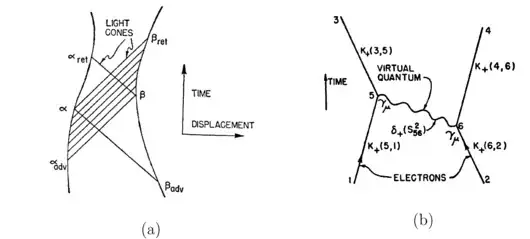As an experimental particle physicist I stick to observables . The complicated mathematical functions which have been established as necessary to describe the quantum mechanical state function of the particles under consideration are not observable.
By the postulates of quantum mechanics the complex functions of space time or energy momentum are not interpreted as a trajectory of the particle under consideration, but squared give the probability of finding the particle at that space time point or that energy momentum values.
Assigning a particle mass to a specific four vector and contemplating the mathematics is a semi-classical way of looking at the problem. This is legitimate as long as one can keep clear in his/her mind that it is a mathematical tool in understanding the functional behavior of the solutions. After all it seems that Feynman was contemplating zitterbewegung when he came up with his famous diagram and "virtual quantum" which turned into virtual particles in the development of the method.

11.5 Graphical representation of the electromagnetic interaction between two particles (a) in Wheeler’s and Feynman’s alternative classical electrodynamics (Wheeler and Feynman 1949, 431) and (b) in Feynman’s approach to quantum electrodynamics (Feynman 1949b, 772).
At present physics is clear on the difference between "virtual" and "real". The first are four vectors with the quantum numbers of the particles but off mass shell, and the second are on mass shell. Measurable manifestations of quantum mechanical calculations appear only for on mass shell particles.
In the state function which models an electron as a wave packet of plane waves, the plane waves are a mathematical tool, as the sines and cosines in a Fourier expansion are a mathematical tool. It is only the integrals and the square of the function that have a physical meaning. A classical analogy: take an object, and the function that describes the surface in space, and expand it in a mathematical series with infinite terms and range. Does it mean that the ball or part of it is spread out to infinity? It is just a mathematical model useful for describing the object in the computer..
I know that, according to Bohr's model, light is emitted when the electron "jumps" between different energy states.
Bohr's model is a wrong one off model that was very useful for bringing in quantum mechanics. Quantum mechanics is a general theory superseding the planetary model. Light is emitted by a charged particle in a bound state if there exists an energy level lower for the transition. In the case of a free electron there is no bound state, and no lower energy state for the electron to occupy.
With this in mind, my question is: is light emitted in this trembling motion of the electron?
In these pragmatic terms zitterbewegung cannot emit light for several reasons, including energy conservation, but primarily because it is a virtual motion arising from the particular mathematical model used to describe a relativistic electron running along.
